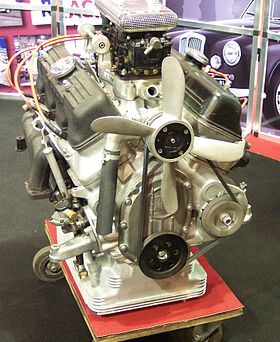Our website is made possible by displaying online advertisements to our visitors.
Please consider supporting us by disabling your ad blocker.
Lancia V6 engine
This article needs additional citations for verification. (January 2019) |
| Lancia V6 engine | |
|---|---|
 | |
| Overview | |
| Manufacturer | Lancia |
| Production | 1950–1970 |
| Layout | |
| Configuration | Naturally aspirated 60° V6 |
| Displacement | 1.8 L; 107.0 cu in (1,754 cc) 2.0 L; 121.5 cu in (1,991 cc) 2.3 L; 138.3 cu in (2,266 cc) 2.5 L; 149.6 cu in (2,451 cc) 2.5 L; 150.0 cu in (2,458 cc) 2.8 L; 169.3 cu in (2,775 cc) |
| Cylinder bore | 70 mm (2.76 in) 72 mm (2.83 in) 78 mm (3.07 in) 80 mm (3.15 in) 85 mm (3.35 in) |
| Piston stroke | 76 mm (2.99 in) 81.5 mm (3.21 in) 85.5 mm (3.37 in) 82 mm (3.23 in) |
| Cylinder block material | Light alloy[1] |
| Cylinder head material | Aluminium alloy[1] |
| Valvetrain | OHV 2 valves x cyl. |
| Combustion | |
| Fuel system | Carburetor |
| Fuel type | Petrol |
| Cooling system | Water-cooled |
| Output | |
| Power output | 56–152 hp (42–113 kW; 57–154 PS) |
In 1950, Lancia introduced one of the world's first production V6 engines in the Lancia Aurelia.[1] The engine was the work of Francesco De Virgilio and was developed to solve the vibration problems Lancia had experienced with its V4 engines. This was achieved by setting the vee angle to 60 degrees. It remained in production through 1970. Lancia used V6 engines in road and sports cars, the D20 had a 60 degree quad cam V6 2962 cc 217 bhp (162 kW; 220 PS) engine and the D24 3300 cc V6 engine.[2]
- ^ a b c "Lancia Coupés & Convertibles". ritzsite.net. Retrieved 2007-09-15.
- ^ "Lancia Heritage". uniquecarsandparts.com.au. Retrieved 2007-09-15.
Previous Page Next Page


